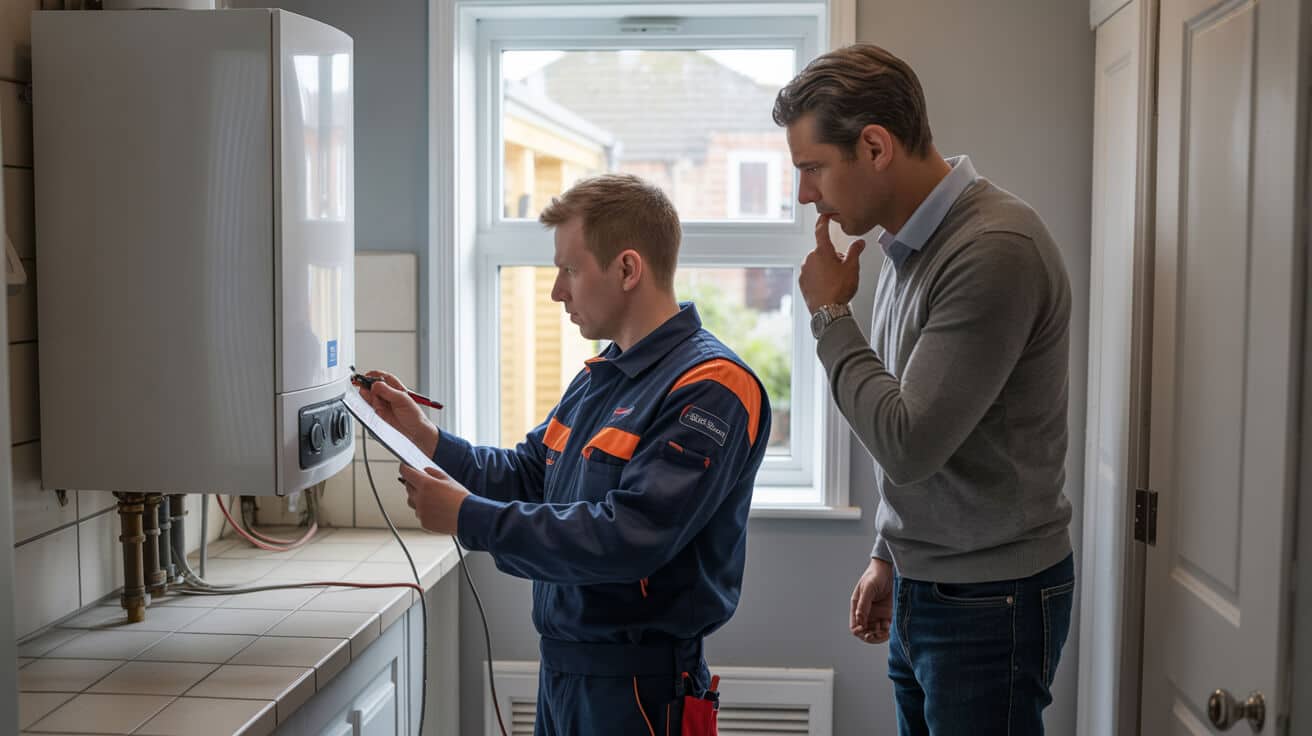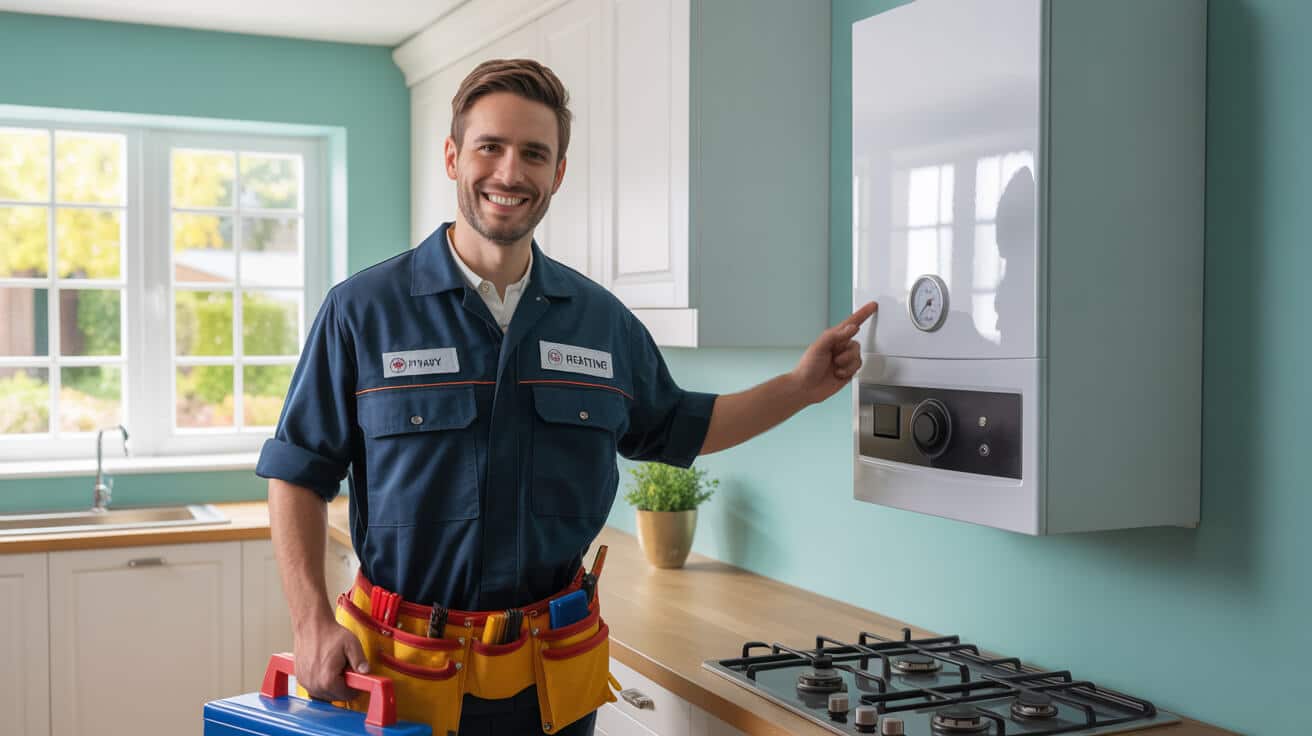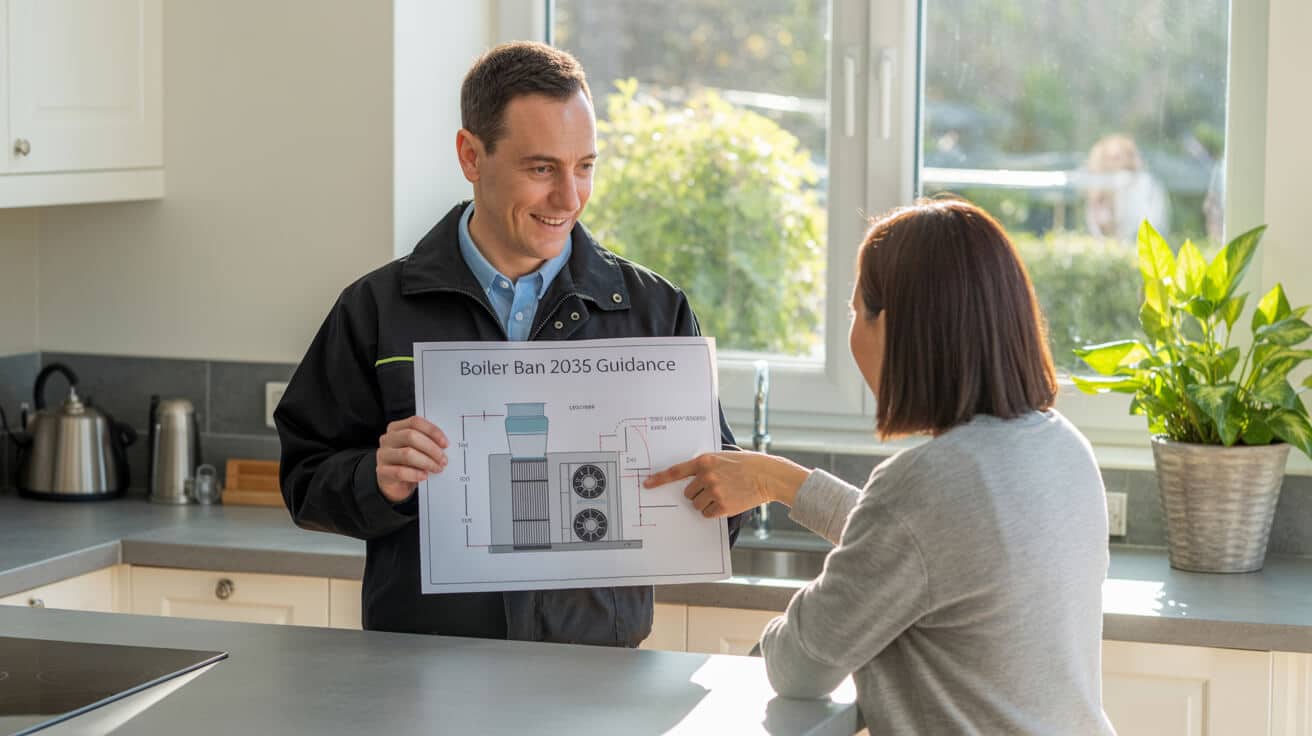 15 Common Boiler Repair Questions Answered
15 Common Boiler Repair Questions Answered

Is Your Boiler Hiding Problems? Spot the Warning Signs Before Your Comfort Is at Risk
Heating failures almost never happen out of the blue. Whether you own a family home, manage rental flats, or look after commercial properties, the typical breakdown begins with small but telling clues: a clunk from the boiler, an error code blinking back at you, or radiators that just don’t get as warm as they used to. People who spot these patterns early avoid repair chaos, inflated bills, and the legal headaches that follow when standards aren’t met.
Most breakdowns start whispering—catching those clues early keeps your money and your peace of mind secure.
A strange damp patch under the boiler or a heating pressure number that sinks over a few days isn’t just “bad luck.” Modern sealed systems are designed to signal when something’s wrong, well before the house goes cold or the office staff start calling in complaints. Overlooking these signals risks more than comfort; it can mean water damage, missed compliance deadlines, and insurance refusals.
Imagine this in practice: You check your boiler’s display every Sunday and jot down the pressure in a notebook. One week, the pressure reads 1.2 bar. The next? Down to 1.0. You hear a new ticking sound. Logging these changes means when you ring Plumbers 4U, you hand them a ready-made diagnostic shortcut—cutting service time and cost.
What Are the Early Warning Signs of Boiler Trouble?
Knowing what to look for puts you in control. The early warning list:
- Frequent error codes or blank screens: Record codes and reset behaviour—repeat offenders need fast action.
- Radiators cool at the top (or everywhere): Air blockages for one rad; system sludge, pump issues, or poor balancing if several are cold.
- Pressure loss below 1.0 bar: Constant topping-up signals a leak or failed vessel—not a DIY fix long-term.
- Odd noises (rumbling, ticking, kettling): These mean air, limescale, pump bearing wear, or flow restriction.
- Leaking joints or water marks near the boiler: Even a tiny patch points to deeper trouble.
- Intermittent heat or hot water drops: Sensors, diverter valves, or electrical connections may be on the brink.
Add photos and dates to your “boiler log.” This habit shaves precious minutes off every repair, helps document property care for audits, and puts you in a far stronger position if you ever need to challenge a denied claim with insurers or regulators.
Why Logging Boiler Clues Matters
Letting issues go unrecorded turns easy fixes into big, disruptive jobs—especially for those overseeing busy sites or rental portfolios. A note today can mean a “ten-minute tweak” instead of weeks of downtime and a compliance scramble.
Why Does Boiler Pressure Drop So Often? Uncovering the Causes and Risks

If you’re topping up your system more often than not, that’s a neon warning light, not a routine chore. A sealed heating system should keep pressure steady for months—in the 1.0–1.5 bar range when cold. If that gauge keeps dipping and the fix is just “add more water,” the problem is only masking itself. Real damage is ticking along in the background.
A dropping gauge means water’s leaving your system somewhere—every top-up sacrifices protection from rust, leaks, and breakdown.
The most common culprits for falling pressure:
- Small, ongoing leaks: Pipe, valve, or radiator joints that ooze into hidden spaces—especially below floor level.
- Worn expansion vessel: This critical part absorbs pressure spikes. When it fails, excess pressure vents out and the system drains.
- Pressure relief valve seepage: Designed to protect, but if stuck or failing, can steadily vent water.
- Auto air vent faults: Remove air but sometimes leak water externally; not always easy to spot.
- Leaks in underfloor pipework (common in older builds or extended systems): Hard to see, big on disruption if ignored.
Refilling the boiler seems easy, but it’s fool’s gold. Each top-up washes corrosion inhibitors out—meaning scale, rust, and eventual pump or heat exchanger failure. Delay also risks breaching manufacturer and legal warranties, which is particularly daunting for landlords, letting agents, and those responsible for compliance.
Plumbers 4U goes beyond guesswork with modern leak tracing—using thermal imaging, dye injection, and acoustic sensors. Leaving pressure loss unaddressed is a sure-way to bigger repair bills, property damage, and future non-compliance issues.
The Real Dangers of Ignoring Pressure Loss
- Water damage: (floors, walls, or insulation in unseen places).
- Rust and sludge: formation, slicing efficiency and causing pump failure.
- Voided warranties: and no legal cover under rental guidelines or insurance.
- Soaring costs: that spiral with every month of delay.
Smart owners log every fill, note the pattern, and present this info to engineers for a faster, cheaper resolution. Don’t settle for patchwork when lasting protection costs less in the end.
Are Error Codes and Blank Boiler Displays Serious? Decoding Your Boiler’s Digital Clues

Every beep, blink, and code from your boiler is a direct signal from the system—often easy to overlook, but not wise to ignore. Treat each code as valuable guidance, not a nuisance to be swatted away with a reset.
Record error codes as you see them—a single detail could spare you hours of downtime and hundreds in repair fees.
Common error code patterns:
- Pressure-related errors: (often E1xx or F1/F22): These warn of water loss or pressure sensor failure.
- Ignition and flame errors: Repeated “F” codes can signal failing spark electrodes, blocked flues, or gas supply issues.
- Sensor or temperature faults: Codes like “NTC” or “probe error” mean a water temp or safety thermostat problem.
- Blank screen: Typically a power supply issue; first, check your fused spur is on and that home circuits haven’t tripped.
Urgency matters: Some codes can be cleared with a single reset, but any code that comes back—especially in combination with dips in pressure or visible leaks—needs urgent investigation from a qualified engineer.
Under UK law and insurance terms, no one except a Gas Safe or G3-certified professional should open the boiler casing—doing so voids cover and can leave your site uninsured.
What’s the Right Move When You See a Boiler Error?
- Log everything: Date, time, boiler status, and what you were doing when the fault appeared.
- Do not reset more than twice: Persistent issues risk escalation—each reset can cause further stress to the internal components.
- Never open casing: Certification is a legal must; penalties are severe.
- Request a repair log: Every professional visit should leave you with written evidence and a compliance trail.
If you want engineers to get to the root fast, arm them with dates, photos, and a full record of what the system “said.” Plumbers 4U uses your logs for a swift, compliance-driven fix, giving you more leverage with auditors and insurers, too.
Can You Re-Pressurise a Boiler Yourself, or Is an Engineer Needed Every Time?

modern boilers have been designed to empower users—with one eye on convenience, the other on safety. Most UK systems allow you to top up pressure via a filling loop, but this power is meant for occasional use, not as a routine fix.
Safe Boiler Pressurisation: Follow This Owner’s Sequence
- Allow full cooldown—the pressure must be checked and topped up cold.
- Find the filling loop: Look for a short, flexible hose under the boiler, flanked by two small valves.
- Open valves gently until the gauge approaches 1.2–1.5 bar.
- Close both valves firmly. If a detachable loop, remove and stow it.
- Check again after 24 hours. A rapid drop signals a persistent system fault.
Top-up more than twice a year? That’s not normal. Each refill depletes the chemical inhibitor, exposing system parts to scale, corrosion, and inefficiency. For landlords, property managers, and anyone under compliance regimes, frequent top-ups are a warning that action—not just more water—is needed.
The best engineers don’t gatekeep knowledge—Plumbers 4U will walk you through this task, alongside a safety talk.
If the pressure stays up for several months after your refill, relax. Drop again soon after? Don’t keep topping up—document the pattern, then arrange an engineer visit. Engaged owners and property managers are a dream client for any contractor who actually values your investment.
Why Do Radiators Stay Cold, Even with the Boiler On?

Nothing saps confidence in your system like cold radiators in mid-winter, especially after hours wasted checking programmers and thermostats. The real cause almost never starts with fancy controls—it’s about flow, air, or debris in the system.
Pinpointing Radiator and System Heating Issues
- Single cold radiator: Often, bleeding is enough—simply open the bleed valve at the top until air hisses out and water follows, using a bleed key or flathead.
- Several cold or tepid radiators: Usually a sign of flow problems. Could be sludge (magnetite build-up), partly closed lockshield valves, or pump decline. In multi-storey or large buildings, balancing (adjusting the flow through each radiator) is often needed.
- Radiators cold at bottom or noisy: Indicates sludge and scale. Power flushing removes debris, restoring efficiency.
- Pump noise or total silence: If the hum you usually hear is gone, or replaced by ticking/grinding, it’s time to call in diagnostics.
If multiple rads cool down at once, it’s almost never a thermostat glitch—think flow blockage first, not tech.
Photos and a simple radiator-log (“which room, how cold, valve settings, noises”) make on-site visits faster and keep your compliance documentation audit-ready. Commercial property managers, in particular, should maintain this level of detail for each occupied unit.
Troubleshooter’s Table
A quick matching guide saves wasted time:
| Symptom | Likely Fault | Recommended Step |
|---|---|---|
| Top cold, bottom hot | Air in system | Bleed with vent key |
| Whole rad cold | Valve or debris block | Check, clean, flush |
| Several rads cold | Pump, balance, sludge | Engineer assessment |
The key: don’t let a comfort issue spiral into a compliance or maintenance headache. Your logbook is as valuable as your toolkit.
What Should You Do When Boiler Leaks, Odd Noises, or Loss of Hot Water Occur?

Water escaping from a boiler or pipe, an unexplained rattle, or a sudden loss of hot water is never “standard maintenance.” These symptoms demand immediate action, not tweaks or resets.
Water near wires? Power down at the fused spur and call an engineer—never risk shock or fire.
The essential moves:
- Spot a leak?: Isolate the system—close stopcocks or valves—then mop excess water and clear the area.
- Hear banging or whistling?: This suggests kettling (steam bubbles from scale build-up), pump cavitation, or blocked components. If bleeding and balancing don’t help, shut off and book a qualified check.
- No hot water or heating at all?: Log any error codes, confirm electrical power with other appliances, and avoid repeated resetting—each attempt can increase damage.
- Repeated tripped fuses or breakers?: Electrical safety first. Secure the area and wait for a certified engineer.
- Never patch or tape leaks inside the boiler.: Warranty, safety, and compliance demand professional fixes.
Homeowners and portfolio managers alike should ensure incidents are captured in photos, time-stamped, and reported to both insurer and service contractor. For major water escape, reach out for insurance advice fast—acting quickly can mean the difference between a minor repair and large-scale property loss.
Waiting for the engineer? Keep kids, tenants, and staff away from danger areas. Keep documentation in hand—it’ll speed up reporting, compliance, and prevent misunderstandings about who’s responsible and when the fix happened.
How Do Warranty, Insurance, and Compliance Interact During a Boiler Repair?

Plumbing and heating repairs in the UK don’t just answer to the thermostat—they answer to a weave of standards, codes, and insurance terms. Each plays a part, and overlooking even one can turn a straightforward fix into a headache with real cost.
One missed certificate and your insurance or warranty might not pay out—peace of mind means paperwork, not just a running machine.
What matters most:
- Valid service history: Keep every maintenance invoice (with engineer ID, date, and part numbers), compliance certificate (CP12 for gas, G3 for cylinders), and manufacturer warranty book on hand.
- Certified professionals: Only Gas Safe, G3 (for unvented), and WRAS (for water safety) credentials count; DIY or “handyman” jobs risk repair refusal.
- Use WRAS-approved components: It’s the law for drinking water, and most insurance instructs repair teams to log proof.
- Before and after photo evidence: Auditors, insurers, or managing agents need to see changes, especially on repeat faults or high-risk sites.
For landlords and managing agents, the cost of a missing CP12, sub-par repair, or lapsed certificate is more than financial—it opens the door to rent disputes, legal claims, and even property forfeiture in worst-case cases. Plumbers 4U builds documentation into every task so your handover is ready for audit, claim, or follow-up engineer without extra effort.
Why Regulation-First Repairs Protect You: What Plumbers 4U Does Differently

Anyone can swing a spanner, but few care about the system as a whole. Plumbers 4U raises the bar with an approach that values the unseen—tracing, proving, and documenting every step for your protection, not just quick fixes.
Why this matters for your property, tenants, or boardroom:
- Certified team only: Gas Safe, WRAS, and G3 registered engineers schedule every call—not apprentices sent alone.
- Full diagnostic process: Engineers explain findings clearly in everyday English, providing a written or digital summary for your file.
- Regulatory compliance lock-in: CP12, G3, and full Part G/H/L certifications—issued, stored, and ready, every job.
- Zero guesswork: Leak and fault testing is all done using modern back-up (thermal cameras, dye, pressure logs) to document cause and solution.
- Transparent pricing: Every quote clear, every charge explained—never a surprise on your invoice.
- Stepwise aftercare: Flushing, balancing, and user tutorials close every job. You leave with both a warm home and an informed understanding of your new system settings.
The real sign of trusted repair isn’t the heat—it’s the audit trail, certificate file, and proof that the work wasn’t just done, but done right.
For property stewards under compliance or insurance oversight, this isn’t “nice-to-have” — it’s the difference between business-as-usual and disruption that echoes for months.
Call Plumbers 4U Today for Lasting, Compliant Boiler Repair Peace of Mind
Every problem your boiler tries to hide—whether it’s a lost bar of pressure or a surprise error code—has real consequences: system damage, failed compliance, insurance headaches, and spiralling costs. The difference between a pain-free fix and an expensive disaster comes down to how fast you act and who you trust.
Plumbers 4U stands out for a reason:
- Speed + skill, no compromise: Immediate dispatch of certified engineers, whether you’re a homeowner or run commercial sites.
- Total diagnostic care: Evidence-driven, step-by-step repair—leak tracing, pressure balancing, and compliant components guaranteed.
- Record like a pro: Every job logged, photographed, certified—evidence you’ll need for audits, warranties, and renter protections.
- Focus on you, not just the boiler: Simple, jargon-free explainer at handover, plus digitised manuals and reminders to make every follow-up effortless.
It’s true security—not just warmth—that you need. Choose repairs that keep you, your assets, and your peace of mind covered.
Get ahead of the chaos and cost. Call Plumbers 4U when your system first signals warning. You’ll protect your comfort, your portfolio, and your reputation—because comfort is only the start. Reliable documentation and compliance-first work ensure you’re never in doubt about your property’s care.
Frequently Asked Questions
What early clues reveal deeper boiler problems that could cost you dearly if ignored?
Your boiler rarely fails out of the blue—subtle performance shifts almost always come first. Maybe hot water is slow to appear, the kitchen radiator stays a little too cold, or the pressure gauge keeps heading south for no obvious reason. Don’t dismiss these glitches as “quirks.” Nationwide, the vast majority of emergency breakdowns started with a warning sign that was missed or misunderstood—a survey by the Heating & Hotwater Industry Council showed nearly 9 in 10 winter failures began as low-level symptoms that owners overlooked until things worsened.
Blinking fault codes, slow heat-up, unexpected noises, or a curious drip at the pipework: these are all smoke before the fire. Even a faint whistling (“kettling”) or the odd error code appearing on start-up can elevate a routine winter to a scramble for emergency repairs, higher costs, and days of discomfort.
“What feels minor today can be the only heads-up you’ll get before a system-shutdown hits your week—and your wallet.”
Which small changes should put you on alert?
- Radiators warm more slowly or stay cool at the bottom
- Pressure gauge keeps dropping even after you top it up
- Occasional error flashes (E133, F22, or blank display) disrupt normal operation
- New noises: whistling, tapping, or bubbling on ignition, or at shutdown
- White or rusty streaks at pipe joints or around the boiler base
How does keeping records cut your risk?
Noting the timing, code, and behaviour—even snapping a quick photo—gives your engineer a head start. This can shorten repair time by half and reduce your repair bill, compared to emergency callouts where the root cause isn’t obvious. It also shields your position on warranties—a paper trail is your strongest asset if the breakdown escalates. Plumbers 4U’s certified engineers include photo documentation as part of every service, bringing peace of mind and clarity for landlords, local authorities, and homeowners alike.
Why is frequent pressure topping-up a serious sign instead of harmless maintenance?
Topping up boiler pressure isn’t routine; it’s a distress flare. A healthy heating system should only need a refill every few months, if at all—not every week. When you find yourself reaching for the filling loop repeatedly, you’re likely masking a more significant malfunction—hidden leaks, expansion vessel issues, or even corrosion building up out of sight. A 2022 audit by WaterSafe found that 65% of chronic pressure-loss cases could be traced back to leaks invisible from outside the system.
Over-topping may “fix” the pressure for a few days, but if water is vanishing, your system’s corrosion inhibitor gets diluted, leading to an increased risk of sludge, scale build-up, and warranty voids. Landlords risk failed safety certificates, while homeowners trade cheap refills for escalating energy bills and future damage.
“Every litre topped up without a fix dilutes your protection and nudges your boiler closer to a breakdown.”
Where does the water go?
- Micro-leaks: Damp patches behind washing machines, beneath floors, or under radiators
- Tiny weeps at connections—spotting faint limescale crusts can reveal a slow leak
- Dripping from the pressure relief pipe outside (often missed in winter)
- Undiagnosed failure in expansion vessel or safety valves
Why stepping up to professional diagnosis saves money
WRAS-approved engineers like those from Plumbers 4U use dye testing, digital moisture metres, and pressure trace-back to pinpoint the source—often saving hundreds of pounds by catching issues before they flood properties or corrode key components. Proactive tracing prevents ongoing damage, keeps your warranty safe, and protects your energy rating. If topping up has become your winter ritual, it’s time for an engineered solution—not just another refill.
Which boiler fault codes are safe for you to handle—and when do they become a legal or safety issue?
Your boiler’s fault codes are its way of telling you exactly what’s wrong, but not all warnings are made equal. Low-pressure codes (like F22 or E119) are most common—fixable by a single, careful top-up, as outlined in your manual. If this resolves the error, monitor if it comes back; otherwise, you’re safe to proceed. However, anything implying ignition trouble, gas supply issues (codes like E133, F28), or a dead/blank display is not for owner intervention.
Compliance law and safety standards (Gas Safety Regulations 1998, G3 for unvented cylinders) mean only certified engineers can open a boiler case, work on gas supply components, or reset certain faults. Attempts to override these restrictions can void insurance and put residents or tenants at risk.
“Resetting a red-flag error might silence the beep, but it could silence your insurance cover too.”
Table: Fault codes you may see, and what’s safe to attempt
| Code | What It Implies | Homeowner Can… |
|---|---|---|
| F22/E119 | System pressure is low | Safe: Top up ONCE |
| E133/F28 | Ignition/gas-supply fail | Stop: Engineer only |
| L2/F75 | Pump/water flow trouble | Stop: Engineer only |
| Blank | Power/electronics/fuse | Stop: Engineer only |
Why does code recording matter for landlords and insurers?
Landlords are legally required to keep a record of all faults and repairs—letting agencies increasingly require log entries and proof for property management. For insurance and warranty claims, detailed notes on code, behaviour, and actions taken are often mandatory. Plumbers 4U’s registered engineers automatically supply this trail, closing out every visit with proper compliance logs and a running record for your property.
When is it genuinely safe to repressurise your boiler—and where is the danger line?
On sealed systems, DIY pressure topping is routine only within strict limits. Always consult your handbook: fill only when the system is cold and never beyond the 1.0–1.5 bar mark. If you have to repeat this process within a few days, suspect a hidden leak or a critical part needing intervention. Overfilling can trigger water escape valves, drench sensitive electronics, or invalidate your warranty.
Sharp pressure swings, water around the boiler base, or sudden dial jumps after topping up are all stop signs. Attempting to repressurise while the heating is running, or without letting the system cool first, can potentiate dangerous failures, leaks, or scalds.
“If your boiler’s asking for water again and again, topping up isn’t maintenance—it’s an SOS.”
Steps for safe, compliant DIY pressure topping
- Turn off the boiler, let it sit till cool (minimum 30 minutes)
- Open the filling loop slowly, watching the dial move just to 1.0–1.5 bar
- Shut valves promptly—don’t guess, check your handbook’s ranges
- Bleed radiators, then recheck pressure and monitor for drops
- Repeat only as a one-off fix, never habitually
When should you stop and call for help?
- Pressure won’t hold steady for more than a week
- Pooling water, drips from relief pipes, signs of persistent air in the system
- Uncertainty about how to refill safely or repeated error codes appear
Plumbers 4U engineers walk you through repressurising steps, explaining every dial, valve, and part—then leave you with written and photo guides tailored to your system. Stay empowered, but never out of your safety zone or in breach of your warranty.
Why do radiators stay cold, and what fixes are within reach before you pick up the phone?
Cold radiators—even with the boiler fully running—mean the heat’s not getting where it needs to go. If the top is cool but the bottom’s hot, trapped air is to blame; a quick bleed with the right key (and a towel) can do the trick. But if the symptoms flip (bottom icy, top hot), the culprit is likely sludge, magnetite, or scale—these block heat and need a pro’s touch for a proper system flush and cleaning.
If most radiators are affected, the problem probably lies beyond the radiator itself: pump failure, closed or stuck valves, a blocked philtre, or a glitch in heating controls. Individual radiators may simply suffer from a misbehaving or sticky thermostatic radiator valve (TRV). For smart home or multi-property managers, keeping a location-logged symptom diary sharpens the engineer’s diagnosis and speeds up the fix.
“One cold radiator is an inconvenience, but a cold house is a warning your system needs swift intervention before the next cold snap.”
Checklist: What you can try versus when to step back
- Top of radiator cold: Bleed air, check pressure right after
- Bottom cold: Requires pro flush or internal clean—don’t force
- Multiple cold units: Check all valves open, test heating controls, look for pump noise
- Isolated cold: Try gently turning the TRV all the way on/off; it may be stuck
Smart aftercare brings future comfort
Plumbers 4U’s engineers provide a before/after photo record and personalised radiator log, making ongoing troubleshooting easy for property managers and homeowners. A performance audit after every callout ensures you know which changes are likely to last, with practical tips to keep your heating bill in check.
How do you handle a leak or water pooling by the boiler without risking your warranty or safety?
Water where it shouldn’t be—beneath or inside the boiler, on the floor, or near sockets—requires action that puts safety first. Immediately shut off the boiler power only at the fused spur (leaving the main fuse box untouched). If accessible without risk, isolate the water supply at the local valve or stopcock. Recognise that opening the boiler casing is strictly for G3 or Gas Safe engineers: overstepping here isn’t just risky—it can make your insurance and warranty worthless.
Photo-document any water, affected areas, odd smells, or nearby electricals; this log is vital for insurance claims and protects you in landlord or agent-relations. For leaks involving electrics, odd odours, or a burned smell, evacuate the area before calling for emergency action—not just routine repair.
“Quick thinking when leaks hit doesn’t just save property—it keeps insurance valid and delivers faster, guaranteed repairs.”
Actions for effective, compliant leak response
- Power down at the nearest spur and keep away from wet electrics
- Safely isolate incoming water at the valve or main stopcock
- Take photos, note time and date, document the spread
- Never remove the boiler cover or attempt internal repairs yourself
Why engineer documentation matters
Professional repair must be followed with a signed repair sheet and a detailed replacement part list—now an insurance must-have for both private homes and all UK landlords. Plumbers 4U provides digital logs and detailed after-action records as part of every job, locking in your peace of mind and your compliance for years ahead.
Which boiler noises can you safely ignore, and when are strange sounds a genuine call for urgent action?
All boilers make background sounds: mild clicking, a faint whir on start-up or wind-down. But banging, bubbling, whistling, and persistent hissing are signals that cannot be ignored. “Kettling” or bubbling may mean dangerous limescale in the heat exchanger—this reduces energy efficiency and can double your fuel bill if ignored. Grinding or whirring might point to a failing pump, circulation fan, or electronics. Loud hissing suggests leaks or pressure faults.
A short audio or video recording lets your engineer hear the problem in context, offering a huge head start for remote diagnosis or evidence for insurance. The Association of British Insurers now encourages evidence logs to control claims and accelerate settlement.
“The cost of ignoring new boiler noises is not just inconvenience—it’s risk to your safety, warranty, and property value.”
Table: Matching the sound to the solution
| Noise Type | Most Common Cause | Recommended Action |
|---|---|---|
| Loud banging | Scale, air, or pump trouble | Engineer power flush, test |
| Bubbling/kettle | Limescale or sludge | Engineer system clean, dose |
| Grinding/whirr | Pump, fan, or PCB issue | Professional diagnosis |
| Persistent hiss | Leak or gasket fail | Leak trace, part replace |
Keeping your boiler safe and compliant
Plumbers 4U’s trained engineers link every noise to its root cause, document procedures, and ensure your claim or compliance documentation is rock-solid. This prevents repeat breakdowns and gives you full confidence—whether for insurance, letting agent standards, or maintaining your property’s value through harsh winters.
Plumbers 4U: Setting the Standard for Safe, Certified, and Client-Focused Boiler Solutions
Every property owner, landlord, or property manager is responsible for more than just fast fixes—they need WRAS-approved, Gas Safe, and G3-certified support teams that log, explain, and guarantee every step. Plumbers 4U delivers evidence-led, compliant repairs that stand up to scrutiny whether you’re protecting your family, your tenants, or your investment. Book a visit now for peace-of-mind heating that’s safe, warm, and always accountable.

